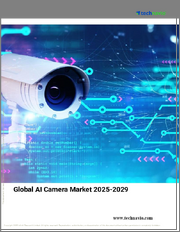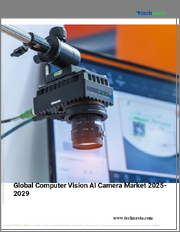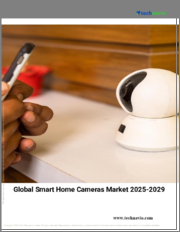
|
시장보고서
상품코드
1622931
세계의 스마트 카메라 시장 규모 : 용도별, 접속성별, 기술별, 지역별, 범위 및 예측Global Smart Camera Market Size By Application, By Connectivity, By Technology, By Geographic Scope Size And Forecast |
||||||
스마트 카메라 시장 규모와 예측
스마트 카메라 시장 규모는 2023년에 65억 2,000만 달러로 평가되며, 2024-2030년의 예측 기간 중 10%의 CAGR로 성장하며, 2030년에는 127억 1,000만 달러에 달할 것으로 예측됩니다.
세계의 스마트 카메라 시장 성장 촉진요인
스마트 카메라 시장 시장 성장 촉진요인은 다양한 요인의 영향을 받을 수 있습니다.
보안 및 영상 감시 시스템에 대한 요구가 증가하고 있습니다.
스마트 카메라에 대한 수요는 상업, 산업, 주거 등 다양한 산업에서 보안 및 모니터링에 대한 중요성이 높아진 데 따른 것입니다. 이러한 카메라에는 영상 분석, 얼굴 인식, 실시간 모니터링 등의 기능이 자주 탑재되고 있습니다.
이미지 센서 기술 향상:
CMOS 및 CCD 센서와 같은 이미지 센서 기술이 계속 발전함에 따라 스마트 카메라는 더 빠르게 정보를 처리하고, 더 나은 이미지를 생성하고, 저조도에서도 더 잘 작동할 수 있게 되었습니다. 이러한 기술 발전은 스마트 카메라의 전반적인 기능과 능력을 향상시키고 있습니다.
머신러닝(ML)과 인공지능(AI)의 통합:
시각 데이터의 실시간 분석과 해석은 스마트 카메라의 ML과 AI 기술의 결합을 통해 가능해집니다. 행동 분석, 물체 인식, 예측 분석과 같은 고급 기능을 구현하여 스마트 카메라 시스템의 일반적인 지능을 향상시킬 수 있습니다.
사물인터넷(IoT) 도입 확대 :
스마트 카메라 시장은 IoT 기기의 보급과 네트워크화된 스마트 생태계로의 추진으로 확대되고 있습니다. 대규모 IoT 네트워크에 스마트 카메라가 자주 통합되어 원활한 기기 공유 및 통신을 가능하게 하고 있습니다.
자동차 산업에서의 용도 확대:
스마트 카메라는 자동차 산업에서 주차 보조, 첨단운전자보조시스템(ADAS), 차량 모니터링 등의 용도로 필수적입니다. 스마트 카메라 기술의 도입은 자동차의 안전 기능에 대한 요구가 증가함에 따라 추진되고 있습니다.
소매점 분석 증가:
스마트 카메라는 소매업에서 재고 관리, 통행량 추적, 고객 행동 분석에 점점 더 많이 사용되고 있습니다. 소매업체는 이러한 인사이트을 활용하여 업무 효율성을 높이고, 소비자 경험을 개선하며, 매장 레이아웃을 최적화할 수 있습니다.
엣지 컴퓨팅에 대한 수요:
엣지 컴퓨팅(데이터 처리가 소스(장비 또는 네트워크 에지)에 가까운 곳에서 이루어지는 데이터 처리)은 대기 시간을 줄이고 실시간 처리 능력을 향상시킴으로써 스마트 카메라에 이점을 제공합니다. 이는 보안 영상 분석과 같이 빠른 의사결정이 필요한 용도에 특히 중요합니다.
원격 모니터링 및 홈자동화:
주택용 스마트 카메라의 채택은 스마트홈 솔루션의 확대와 원격 모니터링의 필요성에 영향을 받고 있습니다. 스마트 카메라는 작업 자동화, 모니터링 및 보안을 제공하여 편의성과 안전성을 향상시키기 위해 주택 소유자가 사용하고 있습니다.
원격의료와 원격의료 :
스마트 카메라가 원격의료 솔루션에 통합되면서 원격 진료 및 모니터링이 가능해졌고, COVID-19 팬데믹으로 인해 원격의료 기술 도입이 가속화됨에 따라 의료 용도에서 스마트 카메라에 대한 수요가 증가하고 있습니다.
소형화 및 비용절감:
제조 기술의 발전으로 스마트 카메라의 부품이 소형화되고 비용이 낮아지고 있습니다. 그 결과 스마트 카메라의 가격이 더욱 저렴해졌고, 더 다양한 가젯과 소프트웨어에 통합할 수 있게 되었습니다.
세계의 스마트 카메라 시장 성장 억제요인
스마트 카메라 시장에는 몇 가지 억제요인과 과제가 존재합니다. 여기에는 다음과 같은 것이 포함됩니다. :
비용 제약:
스마트 카메라는 연결 기능, 이미지 처리 능력, 고해상도 센서 등 첨단 기술을 탑재하는 경우가 많습니다. 이러한 기술의 가격대는 특히 예산을 중시하는 기업이나 소비자에게는 부담으로 작용할 수 있습니다.
개인 정보 보호에 대한 우려:
스마트 카메라의 설치가 증가함에 따라 프라이버시 및 데이터 보안 문제가 대두되고 있습니다. 이러한 장비가 시각적 데이터를 수집하고 해석할 때 강력한 프라이버시 보호 조치가 필요합니다.
상호운용성 문제:
스마트 카메라는 때때로 다른 하드웨어 및 소프트웨어와의 상호 운용에 어려움을 겪을 수 있습니다. 스마트 카메라를 기존 보안 시스템이나 IoT(사물인터넷) 플랫폼과 통합하려고 할 때 통합 문제가 발생할 수 있습니다.
복잡한 설치 및 설정 :
어려운 설정 요건과 복잡한 설치 절차는 특히 소비자 시장에서 고객을 멀리하게 만들 수 있습니다. 스마트 카메라가 널리 보급되기 위해서는 설치 및 설정 프로세스를 간소화하는 것이 필수적입니다.
제한적인 표준화:
스마트 카메라 분야에서는 프로토콜과 포맷이 정의되어 있지 않아 다양한 장비와 플랫폼이 서로 통신하는 데 어려움을 겪을 수 있습니다. 호환성과 상호 운용성을 보장하기 위해 표준화 활동은 매우 중요합니다.
제한적인 지식과 교육:
잠재 고객 중에는 스마트 카메라의 모든 기능과 이점을 모르는 사람이 있을 수 있습니다. 소극적인 태도와 잘못된 정보를 극복하기 위해서는 기업과 소비자들에게 교육 및 홍보를 통해 이러한 기기의 장점을 알려야 할 수도 있습니다.
소비전력:
스마트 카메라가 필요로 하는 전력량은 카메라의 특징과 기능에 따라 크게 달라질 수 있습니다. 특히 야외 감시와 같이 연속적인 작동이 필요한 용도의 경우 전력 소비가 문제가 될 수 있습니다.
사이버 보안 리스크:
해킹과 무단 액세스는 스마트 카메라가 취약한 사이버 보안 위험의 두 가지 예에 불과합니다. 사이버 공격을 방지하기 위해 보안을 강화하는 것은 이해 관계자와 사용자의 신뢰를 얻기 위해 필수적입니다.
이용 사례의 제한:
스마트카메라는 감시용으로만 사용할 수 있다는 생각이 시장 확대에 걸림돌이 될 수 있습니다. 산업 자동화, 소매 분석, 헬스케어 등 다양한 용도를 소개함으로써 시장을 확대할 수 있습니다.
규제 대응:
감시, 데이터 프라이버시 및 기타 관련 주제와 관련된 국내 및 해외 법률을 준수하는 것은 때때로 어려울 수 있습니다. 규제를 준수하는 것은 업계에서 인기를 얻기 위해 필수적입니다.
목차
제1장 서론
- 시장의 정의
- 시장 세분화
- 조사 방법
제2장 개요
- 주요 조사 결과
- 시장 개요
- 시장 하이라이트
제3장 시장 개요
- 시장 규모와 성장의 가능성
- 시장 동향
- 시장 성장 촉진요인
- 시장 성장 억제요인
- 시장 기회
- Porter's Five Forces 분석
제4장 스마트 카메라 시장 : 용도별
- 산업용 머신 비전
- 보안과 감시
- 자동차
- 헬스케어
- 가전
- 스포츠 및 엔터테인먼트
- 소매
제5장 스마트 카메라 시장 : 접속성별
- 유선
- 무선
제6장 스마트 카메라 시장 : 기술별
- CCD(전하결합소자)
- CMOS(상보형 금속 산화막반도체)
- 적외선(IR) 센서
- 3D 비전
제7장 지역별 분석
- 북미
- 미국
- 캐나다
- 멕시코
- 유럽
- 영국
- 독일
- 프랑스
- 이탈리아
- 아시아태평양
- 중국
- 일본
- 인도
- 호주
- 라틴아메리카
- 브라질
- 아르헨티나
- 칠레
- 중동 및 아프리카
- 남아프리카공화국
- 사우디아라비아
- 아랍에미리트
제8장 시장 역학
- 시장 성장 촉진요인
- 시장 성장 억제요인
- 시장 기회
- 시장에 대한 COVID-19의 영향
제9장 경쟁 구도
- 주요 기업
- 시장 점유율 분석
제10장 기업 개요
- Hikvision
- Dahua Technology
- Axis Communications
- Bosch Security Systems
- Panasonic i-PRO Sensing Solutions
- Honeywell
- Samsung Electronics
- Sony
- Avigilon(Motorola Solutions)
- VIVOTEK
- Arlo
- Ring
- Google Nest
- Wyze Labs
- Blink
제11장 시장 전망과 기회
- 신규 기술
- 향후 시장 동향
- 투자 기회
제12장 부록
- 약어 리스트
- 전시와 참고 문헌
Smart Camera Market Size And Forecast
Smart Camera Market size was valued at USD 6.52 Billion in 2023 and is projected to reach USD 12.71 Billion by 2030, growing at a CAGR of 10% during the forecast period 2024-2030. Global Smart Camera Market Drivers The market drivers for the Smart Camera Market can be influenced by various factors. These may include: Growing Need for Security and Video Surveillance Systems: The need for smart cameras is being driven by the growing emphasis on security and surveillance across a range of industries, including commercial, industrial, and residential. Features like video analytics, facial recognition, and real-time monitoring are frequently included with these cameras.
Improvements in Image Sensor Technology:
As image sensor technologies, such as CMOS and CCD sensors, continue to evolve, smart cameras are able to process information more quickly, produce better images, and operate better in low light. Smart cameras' entire functioning and capacities are improved by these technical advancements.
Integration of Machine Learning (ML) and Artificial Intelligence (AI):
Real-time analysis and interpretation of visual data is made possible by the combination of ML and AI technologies in smart cameras. By enabling sophisticated functionalities like behavior analysis, object recognition, and predictive analytics, this raises the general intelligence of smart camera systems.
Growing Internet of Things (IoT) Adoption:
The market for smart cameras is expanding due to the spread of IoT devices and the drive toward networked smart ecosystems. Larger IoT networks frequently incorporate smart cameras, enabling smooth device sharing and communication.
Growing Uses in the Automotive Industry:
Smart cameras are essential for uses like parking assistance, advanced driver assistance systems (ADAS), and vehicle surveillance in the automotive industry. The deployment of smart camera technology is being propelled by the increasing need for safety features in automobiles.
Increase in Retail Analytics:
Smart cameras are being used by retailers more and more for inventory management, foot traffic tracking, and customer behavior analysis. Retailers may increase operational efficiency, improve consumer experiences, and optimize shop layouts with the use of these insights.
Demand for Edge Computing:
By decreasing latency and enhancing real-time processing capabilities, edge computing-where data processing takes place closer to the source (on the device or at the edge of the network)-benefits smart cameras. This is particularly important for applications that need to make decisions quickly, such security video analytics.
Remote Monitoring and Home Automation:
The adoption of smart cameras for residential applications is influenced by the expansion of smart home solutions as well as the need for remote monitoring. Smart cameras are used by homeowners to improve convenience and safety by automating tasks, monitoring, and providing security.
Telehealth and Remote Healthcare:
With the growing integration of smart cameras into telehealth solutions, remote healthcare consultations and monitoring are made possible. The need for smart cameras in healthcare applications has increased because to the COVID-19 pandemic's acceleration of telehealth technology adoption.
Miniaturization and Lower Costs:
Improvements in manufacturing techniques result in smaller components for smart cameras and lower costs. As a result, smart cameras are now more reasonably priced and can be integrated into a larger variety of gadgets and software.
Global Smart Camera Market Restraints
Several factors can act as restraints or challenges for the Smart Camera Market. These may include:
Cost Restrictions:
Smart cameras frequently include cutting-edge technologies including connectivity features, image processing power, and high-resolution sensors. These technologies' price tag could be a deterrent, particularly for firms and consumers who are budget-conscious.
Privacy Concerns:
A rising number of smart cameras are being installed, which creates privacy and data security issues. Robust privacy safeguards are necessary as these devices acquire and interpret visual data, as information misuse could result in regulatory issues and consumer reluctance.
Interoperability Problems:
Smart cameras occasionally may experience difficulties interacting with other hardware and software. When trying to integrate smart cameras with pre-existing security systems or IoT (Internet of Things) platforms, integration problems may occur.
Complicated Installation and Setup:
Difficult setup requirements and intricate installation procedures have the potential to turn off customers, especially in the consumer market. For smart cameras to be widely adopted, making the installation and configuration process simpler may be essential.
Limited Standardization:
In the smart camera sector, the absence of defined protocols and formats might make it more difficult for various devices and platforms to communicate with one another. In order to guarantee compatibility and interoperability, standardization activities are crucial.
Restricted Knowledge and Education:
It's possible that some prospective customers are unaware of all the features and advantages of smart cameras. To overcome reluctance and false information, businesses and consumers may need to be informed about the benefits of these devices through education and awareness efforts.
Power Consumption:
The amount of power needed by smart cameras might vary greatly depending on their features and functionalities. Power consumption is a problem, particularly for applications like outdoor surveillance where continuous operation is necessary.
Cybersecurity Risks:
Hacking and illegal access are only two examples of the cybersecurity risks that smart cameras are susceptible to. Increasing security to fend off any cyberattacks is essential to fostering stakeholder and user trust.
Restricted Use Cases:
The idea that smart cameras are only useful for surveillance purposes may hinder the market's expansion. The market can be expanded by showcasing a variety of applications, such as those in industrial automation, retail analytics, or healthcare.
Regulatory Compliance:
Adhering to national and international laws pertaining to surveillance, data privacy, and other relevant topics might be difficult at times. Complying with regulations is essential for gaining traction in the industry.
Global Smart Camera Market Segmentation Analysis
The Global Smart Camera Market is Segmented on the basis of Application, Connectivity, Technology, and Geography.
Smart Camera Market, By Application
- Industrial Machine Vision:
- Smart cameras are used for automated inspection, quality control, and monitoring in industrial processes.
- Security and Surveillance:
- Cameras are employed for video surveillance, facial recognition, and object detection in security applications.
- Automotive:
- Smart cameras are used in automotive applications for driver assistance, parking assistance, and vehicle monitoring.
- Healthcare:
- Cameras utilized in healthcare settings for medical imaging, patient monitoring, and diagnostics.
- Consumer Electronics:
- Cameras integrated into smartphones, smart TVs, laptops, and other consumer electronics devices.
- Sports and Entertainment:
- Cameras used in sports broadcasting, event coverage, and entertainment production.
- Retail:
- Smart cameras for retail analytics, customer behavior analysis, and inventory management.
Smart Camera Market, By Connectivity
- Wired:
- Smart cameras connected through wired interfaces such as Ethernet or USB.
- Wireless:
- Cameras with wireless connectivity options like Wi-Fi, Bluetooth, or cellular networks.
Smart Camera Market, By Technology
- CCD (Charge-Coupled Device):
- Cameras using CCD technology for image sensing and processing.
- CMOS (Complementary Metal-Oxide-Semiconductor):
- Cameras employing CMOS technology, which is widely used in modern imaging sensors.
- Infrared (IR) Sensors:
- Smart cameras equipped with infrared sensors for low-light or night vision applications.
3D Vision:
- Cameras capable of capturing depth information for 3D imaging and spatial recognition.
Smart Camera Market, By Geography
- North America:
- Market conditions and demand in the United States, Canada, and Mexico.
- Europe:
- Analysis of the Smart Camera Market in European countries.
- Asia-Pacific:
- Focusing on countries like China, India, Japan, South Korea, and others.
- Middle East and Africa:
- Examining market dynamics in the Middle East and African regions.
- Latin America:
- Covering market trends and developments in countries across Latin America.
Key Players
- The major players in the Smart Camera Market are:
- Hikvision
- Dahua Technology
- Axis Communications
- Bosch Security Systems
- Panasonic i-PRO Sensing Solutions
- Honeywell
- Samsung Electronics
- Sony
- Avigilon (Motorola Solutions)
- VIVOTEK
- Arlo
- Ring
- Google Nest
- Wyze Labs
- Blink
TABLE OF CONTENTS
1. Introduction
- Market Definition
- Market Segmentation
- Research Methodology
2. Executive Summary
- Key Findings
- Market Overview
- Market Highlights
3. Market Overview
- Market Size and Growth Potential
- Market Trends
- Market Drivers
- Market Restraints
- Market Opportunities
- Porter's Five Forces Analysis
4. Smart Camera Market, By Application
- Industrial Machine Vision
- Security and Surveillance
- Automotive
- Healthcare
- Consumer Electronics
- Sports and Entertainment
- Retail
5. Smart Camera Market, By Connectivity
- Wired
- Wireless
6. Smart Camera Market, By Technology
- CCD (Charge-Coupled Device)
- CMOS (Complementary Metal-Oxide-Semiconductor)
- Infrared (IR) Sensors
- 3D Vision
7. Regional Analysis
- North America
- United States
- Canada
- Mexico
- Europe
- United Kingdom
- Germany
- France
- Italy
- Asia-Pacific
- China
- Japan
- India
- Australia
- Latin America
- Brazil
- Argentina
- Chile
- Middle East and Africa
- South Africa
- Saudi Arabia
- UAE
8. Market Dynamics
- Market Drivers
- Market Restraints
- Market Opportunities
- Impact of COVID-19 on the Market
9. Competitive Landscape
- Key Players
- Market Share Analysis
10. Company Profiles
- Hikvision
- Dahua Technology
- Axis Communications
- Bosch Security Systems
- Panasonic i-PRO Sensing Solutions
- Honeywell
- Samsung Electronics
- Sony
- Avigilon (Motorola Solutions)
- VIVOTEK
- Arlo
- Ring
- Google Nest
- Wyze Labs
- Blink
11. Market Outlook and Opportunities
- Emerging Technologies
- Future Market Trends
- Investment Opportunities
12. Appendix
- List of Abbreviations
- Sources and References












